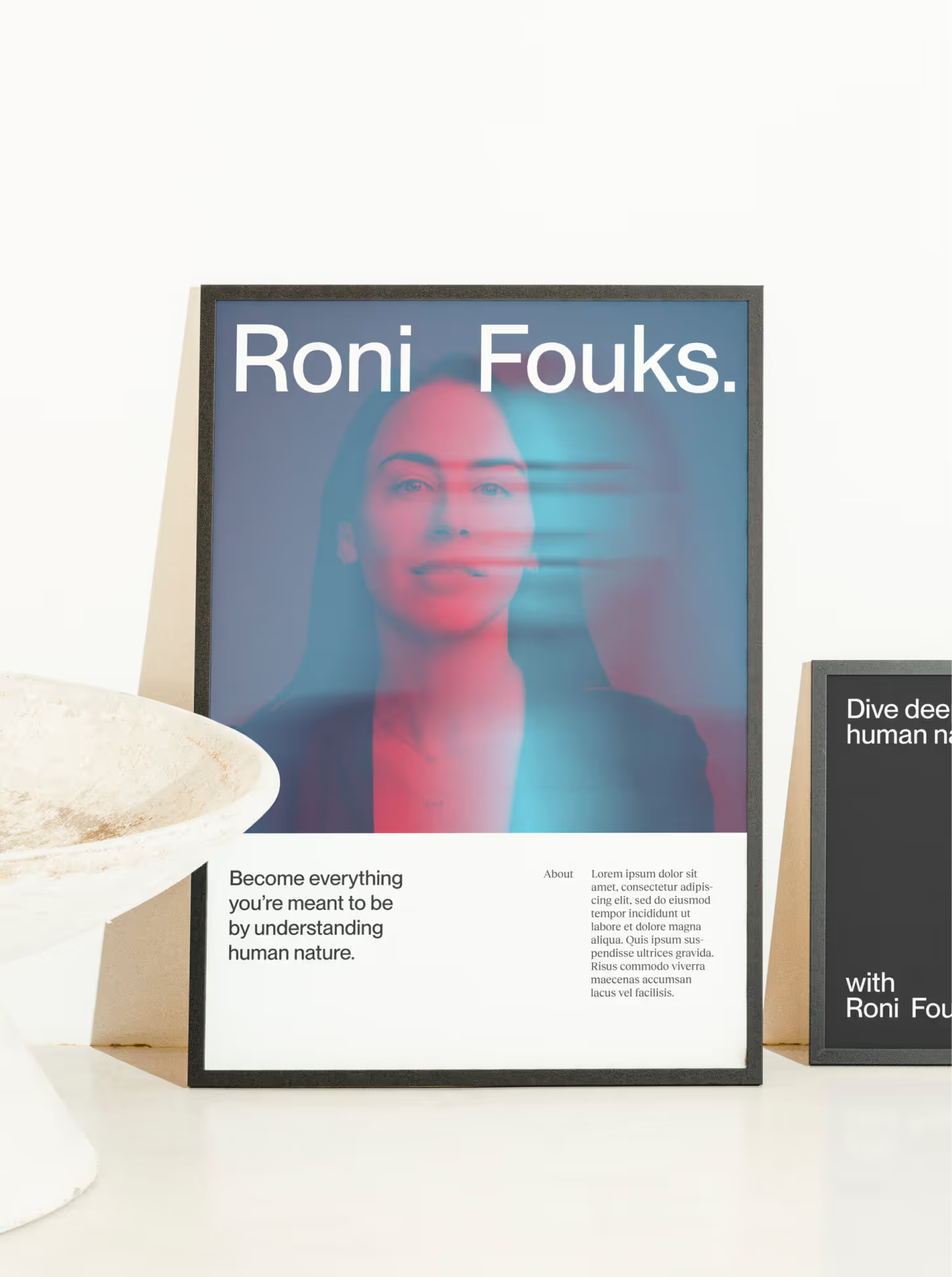Tel Aviv, Paris, San Francisco
Applying Design Thinking to Marketing & Communication.


Defining Design Thinking.
Human-centered design. What?
When we first learned of the Design Thinking method we were under the impression that designers came up with it for non-creative people to have a go at their creative side. However, after much research and comprehension, we came to understand that it is a method in which creativity, ideation and problem solving come strictly with the consumers' best interests in mind.
Using collaborative skills, among many others, you find what would work best for humans, and create it. You test and test and test again until you have the perfect idea fit for your target. The only way to achieve this: Empathy. By mixing the experimental side of creation with a human experience, you are able to create a more viable product. You listen to and feel what your audience is telling you, thereby receiving the most optimal and helpful information to use in the conceptualization of the product, whatever it may be. It is a methodology that aims to answer questions like: ‘What’s the problem?’ & ‘Who are we trying to solve it for?’ You continue to experiment with solutions until you find one that gives you a solution for humans (Doreen Lorenzo, 2018).
As defined by IDEO U, Design Thinking is “a human-centered approach to innovation—anchored in understanding customer’s needs, rapid prototyping, and generating creative ideas—that will transform the way you develop products, services, processes, and organizations. By using design thinking, you make decisions based on what customers really want instead of relying only on historical data or making risky bets based on instinct instead of evidence”.
Design thinking also heavily emphasizes the importance of collaboration and incorporation of people from different backgrounds. In her Ted Talk, Doreen Lorenzo explains that because the world is so incredibly populated, we have no choice but to work with people constantly. Especially people who are not like us. The differences found among those who we collaborate with end up being the most helpful tools when creating something. She concludes her point by demonstrating that the idea of collaboration is to bring multiple ways of looking at a problem because there is never just one way to solve it (Doreen Lorenzo, 2018).

When should Design Thinking be applied?
Design thinking is a trendy concept, that’s for sure. Marketing and communication agencies tend to advertise this approach to express their deep interest for the audience. It’s no news that advertising and marketing is about people! So why do they feel the need to emphasize it?
The best way to sell your products is to make sure that people need it. You may think directly “well, yes of course, that’s basic.” But it’s not. If you had an idea of all the clients telling us what they do, and why they created their product, you would be surprised to see that most of them created a product for themselves, to answer their pain points, because they needed it. So why are they still surprised that it doesn’t sell? “Well, some other people may have the same problem, or the same need!” Of course they do, you're not the only one struggling when it’s a pretty basic problem.
So when is it the best time to consider applying design thinking?:
- If you feel you’ve tried everything and nothing has worked.
- If you feel you missed your target.
- If you struggle to scale.
- If you have a hard time standing out in the crowd.
“Don't find customers for your products, find products for your customers”. Seth Godin
Design Thinking & Entrepreneurship.
Entrepreneurs are naturally always trying to get (and stay) ahead of everyone else. These skills and attributes are the ones that help people stay competitive in the real world. Design Thinking is extremely beneficial for entrepreneurs as it incorporates a side of the creation process that they might not have otherwise been involved in. For this process to uphold, everyone gets involved. Everyone.
Take Apple for example. It is an extremely innovative company, constantly pushing the boundaries creatively. It almost feels as if they come out with something new every other week. This feeling stems from their methodology: every time they release a new product or a new feature, it is curated to exactly what the consumers have been searching for. Despite the small group of people who prefer Android products over Apple products, most Apple users are happy with their product because it was designed with them in mind. Before the creation or ideation of a new product, a creative team consults with the marketing team to ensure that whatever they invent next will solve a problem that the consumers have voiced.
At BRACT, we believe in human. We incorporate kindness and compassion into everything we do because we know, from experience, that it is the most beneficial way to reach our audience. The same applies to Design Thinking. The most helpful tool to utilize when trying to reach your audience is to be relatable. Make them understand that you understand them.
By taking the necessary steps to solve problems that humans face daily, you have the ability to eradicate these problems completely for those who have the ability to obtain your product. That being said, the only way to achieve this is by constantly keeping your consumer in mind.
So, how is it used in marketing & communication?
As we mentioned prior, Apple uses marketing and communication to help visualize and create their products based on what the consumer wants. By using empathy in every step of the creative process, you have the ability to get closer to your audience. The better you understand your audience, the better your product or service will perform.
In terms of marketing and communication agencies, the Design Thinking method is an excellent tool to help understand and become closer to your target audience. It forces the agency to create and put out content that is more relatable to their consumers.
In any marketing, communication or advertising, although they are different, the first thing to consider is the target. You retrieve the knowledge accumulated after studying the audience and use it to define what exactly it is that they are searching for.
Next, you ask yourself and your team how to best solve the problem while considering profit, budget and resources. Incorporating ideas from around your team, nothing is off the table. This is to exercise the creative flow that exists in every entrepreneur. The variety of individuals that make up your team will be able to generate a plethora of ideas.
Begin building the prototypes! Find the best (or best few, if you have the budget) ideas that your team has come up with and bring them into existence. This is the opportunity to avoid solidifying any ideas, otherwise it will curtail them from growing and evolving. The rule of thumb when creating something is to never fall in love with your first idea. If you stick to the first idea you come up with, where is the opportunity to progress?
When you are conceptualizing the physicalities of your product, keep the five senses in mind. We recently discussed the importance of incorporating the five senses into your product in order to enhance customer experience. Even if your product isn’t a tangible one (see: software, a website, etc.), make sure the user experience will touch (more than just physically, we mean) your consumer in a memorable way.
After you create the product, test it out. This is your opportunity to understand and analyze how your audience will perceive and interact with your product in general. Find as many methods to test it in as many environments and circumstances as possible. You need to understand exactly how, or if, it will perform in the real world. And if it fails, that’s okay. We’re here to learn. Failing is the best way to do so.
Perfectionism is quite an unattainable standard set in the business world for entrepreneurs to strive for. However, the reality is, it does not exist. No one definition or description of perfection is the correct one. Following this ideology can be extremely detrimental to an entrepreneur’s career. We wrote a bit about how to cope with these high standards in the industry, and how to combat them.
If you truly feel that your product is PERFECT, it’s time to send it on its way (to the consumers, of course).
But remember, this process isn’t built for a one-time occurrence. There will be instances where you and your collaborators will have to regress and return to different parts of the method to better your practices. This is totally okay. If you get to the end of the process, and you decide you want to completely scrap the entire idea (we really hope this doesn’t occur), or you want to go back to the prototype stage to change just one little thing, do it. There is no better time than now. The process is meant to assist you in creating the absolute best product possible. And, after all, Rome wasn’t built in a day.
Good luck!
Citations:
Design Thinking. IDEO U. (n.d.). https://www.ideou.com/pages/design-thinking.
How can Design Thinking be used in Marketing Agencies? ". Digital Eggheads. (2019, November 12). https://digitaleggheads.com/how-can-design-thinking-be-used-in-marketing-agencies/.
Pateva, D. (2020, September 17). 7 of the most profitable companies using design thinking for innovation. fabrica360. https://www.fabrica360.eu/post/7-of-the-most-profitable-companies-using-design-thinking-for-innovation.
YouTube. (2018). Design Thinking | Doreen Lorenzo | TEDxUTAustin. YouTube. https://www.youtube.com/watch?v=a_lwKwn4J8A.
The Bract Agency is a branding, digital, growth agency in Tel Aviv, Paris, & San Francisco. We team up with startups and entrepreneurs to transform potential into growth.
Learn more


